
The bulbuls are members of a family, Pycnonotidae, of medium-sized passerine songbirds, which also includes greenbuls, brownbuls, leafloves, and bristlebills. The family is distributed across most of Africa and into the Middle East, tropical Asia to Indonesia, and north as far as Japan. A few insular species occur on the tropical islands of the Indian Ocean. There are 166 species in 32 genera. While different species are found in a wide range of habitats, the African species are predominantly found in rainforest, whereas Asian bulbuls are predominantly found in more open areas.

The yellow-browed bulbul, or golden-browed bulbul, is a species of songbird in the bulbul family, Pycnonotidae. It is found in the forests of southern India and Sri Lanka. The yellow-browed bulbul is mainly yellow on the underside and olive above with a distinct yellow brow. They are easily located by their loud calls but tend to skulk within foliage below the forest canopy. While its taxonomic classification has changed over time, it is currently the sole species within the monotypic genus Acritillas which is closely related to Hemixos.
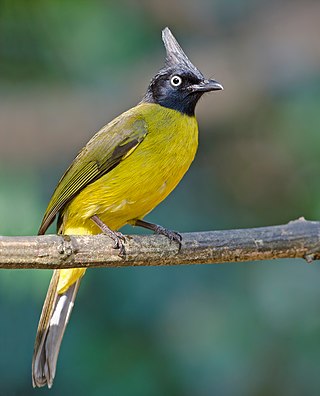
The black-crested bulbul is a member of the bulbul family of passerine birds. It is found from the Indian subcontinent to southeast Asia.

The cinereous harrier is a South American bird of prey of the harrier family. Its breeding range extends from the Tierra del Fuego through Argentina and Chile to Bolivia, Paraguay, Peru and southern Brazil; and across the Andes north to Colombia. The bird's population is declining but due to its large range is not considered vulnerable. The term cinereous, deriving from the Latin word for ashy, describes its colouration.
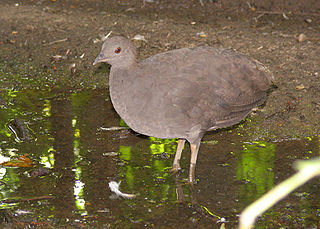
The cinereous tinamou, also known as brushland tinamou, is a type of ground bird found in swamp and lowland forests in northern South America. They have some localized names that have been used by the indigenous people such as in Amazonas where they are called inambu-pixuna, and in Pará, Brazil where they are called nambu-sujo. Also, throughout their range they are called inhambu-preto. Cinereous tinamous have been around for many centuries. They are part of the oldest families of the world today and have fossils discovered dating back tens of millions of years. Their quick reflexes play a role in their ability to survive.
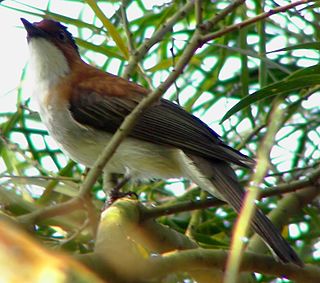
The chestnut bulbul or chestnut-backed bulbul is a songbird in the bulbul family, Pycnonotidae. The species was first described by Robert Swinhoe in 1870. It is found in southern China and northern Vietnam. Its natural habitat is subtropical or tropical moist lowland forests.

Hemixos is a songbird genus in the bulbul family, Pycnonotidae.

The ashy bulbul is a species of songbird in the bulbul family, Pycnonotidae. It is found on the Indian subcontinent and in Southeast Asia. Its natural habitats are subtropical or tropical moist lowland forest and subtropical or tropical moist montane forest.

The Malagasy bulbul is a species of songbird in the bulbul family, Pycnonotidae. It is found on Madagascar and other regional islands in the south-western Indian Ocean.

Hypsipetes is a genus of bulbuls, songbirds in the family Pycnonotidae. Most of its species occur in tropical forests around the Indian Ocean. But while the genus is quite diverse in the Madagascar region at the western end of its range it does not reach the African mainland.
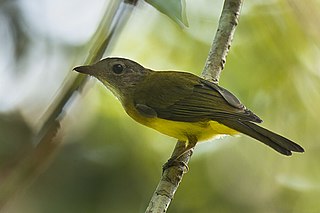
The yellowish bulbul is a species of songbird in the bulbul family, Pycnonotidae.

The streaked bulbul, or green-backed bulbul, is a songbird species in the bulbul family (Pycnonotidae). It is found on the Malay Peninsula, Sumatra, and Borneo. Its natural habitat is subtropical or tropical moist lowland forests. It is becoming rare due to habitat loss.

The grey-bellied bulbul is a species of songbird in the bulbul family. It is found on the Malay Peninsula, Sumatra and Borneo. Its natural habitat is subtropical or tropical moist lowland forests. It is threatened by habitat loss.

The scaly-breasted bulbul is a species of songbird in the bulbul family. It is found from the Malay Peninsula to Borneo. Its natural habitat is subtropical or tropical moist lowland forests. It is threatened by habitat loss.
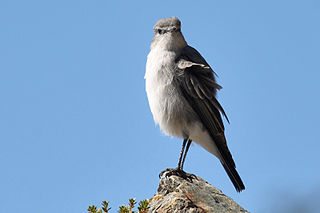
The cinereous ground tyrant is a species of bird in the family Tyrannidae. The term cinereous describes its colouration. It is found in Argentina, Bolivia, Chile, and Peru. Its natural habitat is subtropical or tropical high-altitude grassland.

The cinereous warbling finch is a species of bird in the family Thraupidae. It is endemic to Brazil. The term cinereous describes its colouration. Its natural habitat is subtropical or tropical dry lowland grassland. It is threatened by habitat loss.

Iole is a genus of songbirds in the bulbul family, Pycnonotidae. They are native to tropical eastern Asia, from India to China and south through Southeast Asia to northern Indonesia.

The Bornean bulbul is a member of the bulbul family of passerine birds. It is endemic to the island of Borneo.

The ruby-throated bulbul, or yellow bulbul, is a member of the bulbul family of passerine birds. It is found on Sumatra, Java, and Bali.

The black-capped bulbul, or black-headed yellow bulbul, is a member of the bulbul family of passerine birds. It is endemic to Sri Lanka.





















